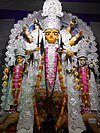Alpana
Alpana or alpona (Bengali: আলপনা) refers to colourful motifs, sacred art or painting done with hands and paint which is mainly a paste of rice and flour on auspicious occasions in Bengal.[1] The word Alpana is derived from the Sanskrit alimpana, which means 'to plaster' or 'to coat with'. Traditionally, it was drawn by the women of the house before sunset. It is also a folk art in Bengal.


Materials used to draw an Alpana[]
Traditionally in Bangladesh, Alpana is white, since the liquid paste used for Alpana is rice powder mixed in water. Nowadays though, there have been more variety in materials. People have started utilizing glue in their Alpana to make the paint more durable. Fabric colors have also started to become an ingredient in Alpana to add color variety to its generally white mix. Traditionally, the green colouration is done by tree leaves and red by sindur. People also color the paint by soaking cotton thread in the paste.
Uses of Alpana[]
This art is known by different names in various parts of India and its use varies from region to region. The most common type of alpana all around India is Rangoli, which uses colored sand to draw a design. The artwork is mainly done by women. They are conscious of the changing moods of the seasons and their creativity thus marks the changing cycle of the year.
Circular alpana is used as a holy pedestal during festivals such as the Bengal, Saraswati puja (also referred to as vasant panchami) in Bengal and the Festival of Lights (Diwali). Items drawn with the technique include the sun, swastika, a rice stem, an owl, a ladder, a plough, the footprints of the goddess Lakshmi, a fish, betel, a lotus, shankhalata (a snake) and some times just some abstract art to look beautiful .
See also[]
References[]
- ^ "Reviving a vanishing folk art form in Bengal". The Hindu. The Hindu Group. 27 December 2016. Retrieved 7 October 2017.
- Indian painting
- Hindu art
- Bengali Hindus
- Culture of West Bengal

